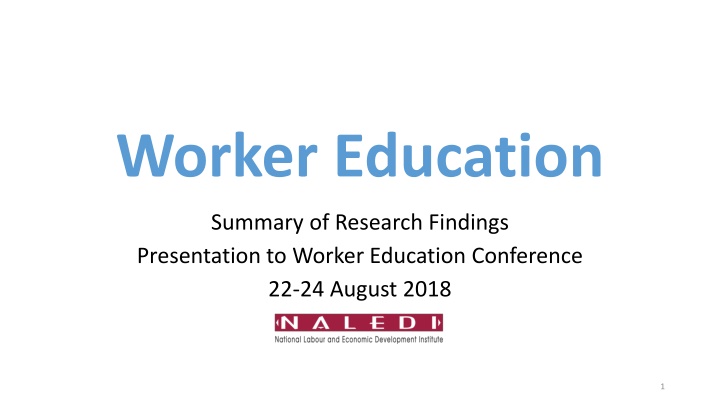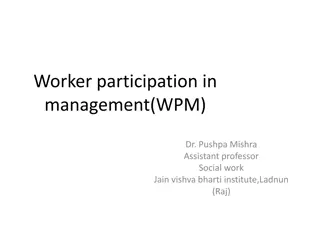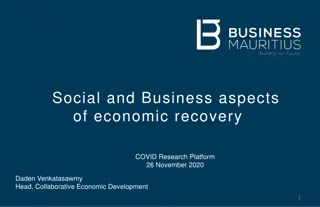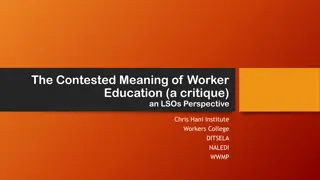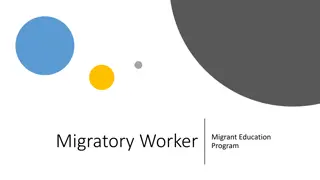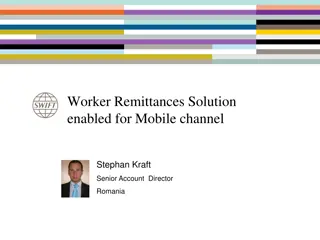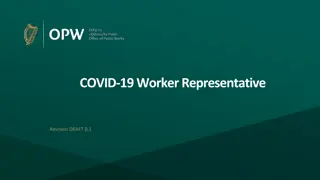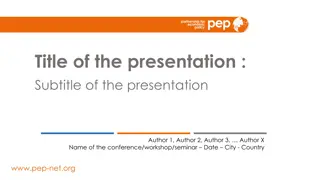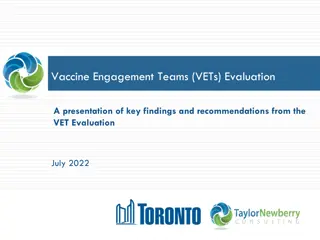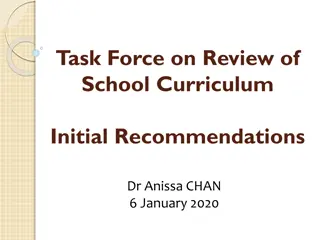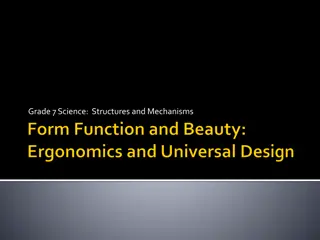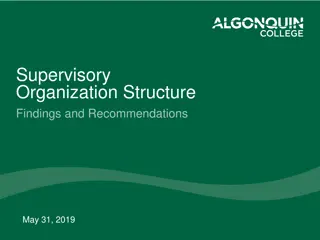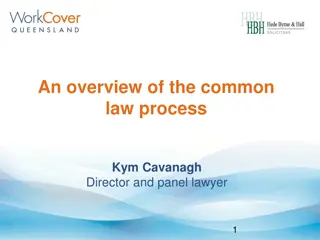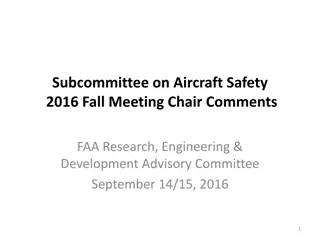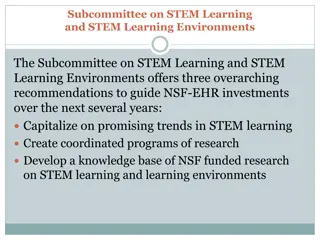Worker Education Research Findings & Recommendations Presentation
Research on worker education focused on auditing programs, analyzing skills needs, developing monitoring tools, proposing sustainable education vision, and policy suggestions. Specific issues, target groups, and barriers were identified, leading to recommendations for provisions, strategies, and pilots to address needs effectively.
Download Presentation

Please find below an Image/Link to download the presentation.
The content on the website is provided AS IS for your information and personal use only. It may not be sold, licensed, or shared on other websites without obtaining consent from the author.If you encounter any issues during the download, it is possible that the publisher has removed the file from their server.
You are allowed to download the files provided on this website for personal or commercial use, subject to the condition that they are used lawfully. All files are the property of their respective owners.
The content on the website is provided AS IS for your information and personal use only. It may not be sold, licensed, or shared on other websites without obtaining consent from the author.
E N D
Presentation Transcript
Worker Education Summary of Research Findings Presentation to Worker Education Conference 22-24 August 2018 1
Worker Education Research Objectives NALEDI was commissioned by the Worker Education Committee to conduct research on Worker Education with the following key objectives: To conduct an audit of current worker education programmes To analyse skills needs for developing worker education To develop tools for ongoing monitoring and evaluation of worker education To develop a vision and proposals for integrated and sustainable worker education To develop policy and funding proposals to support our vision of worker education 2
Data Provision Unions (21) BCAWU CEPPWAWU DENOSA FAWU Hospersa NEHAWU Nulaw NUM POPCRU PSA SACCAWU SACTWU Government DHET x3 DOL SACWU SADTU SAMWU SASBO SATAWU SOLIDARITY UASA UNTU NUMSA Membership Data: 21 unions Shopsteward Data: 20 unions Provision Data: 14 unions SKILLS SAQA SETAs ETDP SETA (also interviewed) HWSETA (also interviewed) CHIETA Food and Bev SETA Merseta Federations COSATU FEDUSA NACTU 3
Needs are more specific issues emerging from the barriers Target Groups are specific actors whose actions and behaviours can be monitored as indicators of outcomes of recommended actions it also suggests a hierarchy of spending Barriers are broad Conclusions/ problems based on data Definition criteria based conceptualisation Worker controlled WE& Skills Development contextual Primary definition Recommendations/ strategies Extension of provision Secondary Operational Objectives Tertiary Policy Institution building Pilots Pilots are specific projects that are used to test methodologies and create building blocks towards integrating strategies pilots have budgets and indicators Objectives are based on the data consultation and conceptualisation Describing the purpose or rationale against which needs are prioritised and strategies focused Recommendations/Strategies are specific and generalised actions targeted at one or across a range of needs but are usually more specific to different target groups 4
Context: Structural Unemployment Changes in employed and unemployed (2008, 2017) 2008 2017 Difference % Change Official Expanded Employed 4,299 6,094 14,549 6,210 9,422 16,192 1,911 3,328 1,643 44.4 54.6 11.3 Combined data on discouraged workers & those unemployed for more than 1 year Jul-Sep 2008 1,093 Jul-Sep 2017 2,436 Difference % Thousands Change Discouraged work-seekers 1,343 122.9 Long-term unemployment (1 year and more) Total 2,552 4,181 1,629 63.8 3,645 6,616 2,972 81.5 5
Employment and union membership Union Density Union membership in formal employment comparing permanent and precarious work contract forms 2017 16,000,000.00 14,000,000.00 12,000,000.00 10,000,000.00 8,000,000.00 16,000,000 6,000,000.00 28% 30% 4,000,000.00 47% 14,000,000 2,000,000.00 12,000,000 0.00 Union Membership Union Membership Union Membership Formal Employment Formal Employment Formal Employment 10,000,000 28% 8,000,000 6,000,000 43% 4,000,000 3% 1990 2000 2017 2,000,000 8% 0 Between 2000 and 2017 permanent employment dropped from 73% to 61% of formal employment. Non permanent work increased by 371% in this period Limited duration Unspecified duration Permanent nature Total formal employment Union Members Formal Employment The Impact of labour market flexibility on union density 7
Concentration of union membership Proportion of national union members Number of Members 2 935 000 2 672 000 2 178 000 1 320 000 20 Unions 15 unions 10 unions 5 unions Federated Membership National membership 74% 68% 55% 33% 3 535 000 90% 3 941 903 100% Membership has become relatively better educated largely as a result of job losses and informalisation in traditional membership sectors and the growth of public sector membership. There is a critical need for WE to extend trade union representation into more precarious work areas. Union members are becoming older and as in the labour market is still skewed towards male membership
Relevance of Worker Education Current contextual challenges facing trade unions, including of casualisation, precarious work, declining union density all point to the need to build organising and organisational capacity The link between education, organising and organisation building is critical Basic organising, representation and organisational skills for shop stewards and organisers are essential for trade unions, must be controlled and delivered by trade unions, and need funding support A broader approach to worker education that brings together workers of different status in workplaces could contribute to building workplace organising strategies and worker unity 9
Working Definition of Worker Education Worker Education is education in the interest of workers by workers, workers organisations and their institutions, for purposes that they themselves determine. Worker education is worker-controlled and working-class oriented with a core objective of building working class unity, collective organisation and solidarity. Worker education is democratic in practice, using participatory, active methods that recognise and value workers knowledge and experience. It is aimed at building working class consciousness for the purpose of advancing working class struggles against all forms of oppression and capitalist exploitation and for social justice & progressive alternatives. The scope of worker education covers a range of content areas ranging from organisational skills, political education, vocational education and adult literacy Workers include employed and unemployed, vulnerable and precarious workers 10
Trade Union Provision Key Findings 14 unions that provided data on SS education had trained a total of 15 061 shopstewards The total number of shop stewards for the sample was 26 636 This represents 56,5% coverage of shopstewards within these 14 unions Total union membership for the sample was 1 819 657, which represents 46% of union membership nationally At least half the unions trained 42% and less The sample was skewed since it targeted better organised, larger trade unions who were able to provide data The research estimates a lower coverage of 35% taking into account smaller unions 11
WE Provision overview WE Provision overview Providers Trade unions and federations Coverage 21 000-24 000 Funding Union budget and SETAs 35% 5 LSOs 3727 over 4 years 6.2% NSF, DOL, Donors 1,6% per year 950 per year Range 900-1100 /year Trade union linked programmes between 150-300 Universities Unions, SETAs, NSF, DOL Union linked and unlinked programmes CCMA Non union linked 1000 union 2128 Unions, SETAs, Govt. Advice Offices 1329 1000 and upward Private providers SETA 12
Programmatic Areas Programmatic Areas Providers Trade Unions and Federations Main Focus Basic Shop Stewards, Trade Union skills, Political education Accreditation Mostly Non Focus Group mostly shop stewards there is no general membership education estimated data Shop stewards, more senior leadership and officials and officials Mixed with better resourced unions covering most representatives but fairly limited in depth training Labour Studies, Political and TU Skills 728 (4 years) 5 LSOs 19.5% accredited Much Lower proportional numerical coverage but more in depth curriculum than union provision supplemental to unions either from a content, resource or non traditional union strong holds Labour Studies and Labour Law L4 and L5 to L7 Longer programmes 3 days to 5 weeks Mostly Accredited Universities officials and senior union leadership Mostly L5-L7 Union-linked and unlinked programmes Short and long programmes 4-5 days to 5 years short programmes 1-3 daysfull time shop stewards, senior shop stewards and officials Mostly Accredited Shop stewards and more senior leadership CCMA Labour law and Dispute, bargaining and SS best practice Private Providers Generic Skills Mostly short programmes 2 days to 2 weeks 13
Educator Profile LSO only TU only male female Average age % above 40 average time in current position Union experience WE experience outside current LSO Adult education experience AET/ABET experience Tertiary education teaching Highest qualification degree post grad certif/diploma matric Qualified assessors/moderators 68% 32% 46 84% 62% 38% 45 81% 80% 20% 48 90% There exists a strong skills set amongst current provision but it is ageing, dominated by men and could have much stronger multiplier impact were there to be stronger provision budgets and the issues of time off for education resolved. 6 8 2.5 100% 48% 24% 42% 58% 10% 19% 48% 76% 5% 19% 30% 20% 20% 0% 32% 26% 32% 10% 38% 38% 14% 10% 20% 0% 40% 10% 29% 33% 10% 14
This related to workplace processes and facilitation skills Learner identified education and information needs skills development Health and safety, this didi not include the HIV/AIDS subset. There were no respondents from a Health and safety related programme and this would tend to provide a lower number in responses Health and safety A number of learners explained they would like further education opportunities but did not have information about what that LSO would or could offer. This included responses related IT skills, information available online and social media use. Membership info related to organising overlapped with this response category. This category included straight forward research skills, being able to find and access information, and using database systems to develop information processing. There is some overlap between this category and the IT and organising sets. Info on further study/Curriculum LSO Learner Percieved Information and knowledge needs Computers and online union Info Labour Law and case Handling Labour Economics and bargaining Organising and servicing Research and Information Other included a range of skills focus areas such as, writing minutes, project management, problem solving and communication Gender related to areas of gender in leadership, collective bargaining and organisation Politics and activism other gender other gender Politics and activism broadly included responses around political economy and broader civil society engagement. The nature of learners and course focus would likely see this category increasing in focus. This included issues of servicing, strategy and tactics, information on members to plan organising. Another common focus was organising in difficult or changing economic circumstances. Research and Information Computers and online union Info Politics and activism Info on further study/Curriculum Health and safety skills development Organising and servicing The responses to the two largest categories are broken down in the graphs that follow The responses to the two largest categories are broken down in the graphs that follow 0 20 40 60 80 100 Labour Economics and bargaining LSO Learner Survey n=135 Labour Law and case Handling 16
Needs Analysis Rebuild and strengthen worker controlled education to confront predominant human capital approach to education Strengthen trade union representation and role in vocational education Extend provision of Worker Education Extend provision of WE to all provinces beyond metro areas Expand provision of basic shop steward education Extend the reach of worker education to vulnerable workers Consolidate WE for organisation building & institutional capacity Consolidate and rebuild capacity of TU educators and LSOs Improve information management, and internal research and monitoring Build up repositories of quality worker education materials and skills Improved coordination of WE between different levels and forms of provision and providers Establish a pathway for worker education that builds organisation and workers 17
Barriers to achieving these objectives The three principal barriers are: The lack of sufficient and sustainable financial resources and the consequent lack of many other resources such as infrastructure. The lack of time off for WE The problem of coordination and collaboration/Inter Institutional Boundaries The three most significant gaps identified: The low level of provision of WE education by trade unions and LSOs to organised workers and shop stewards, changes in the culture/nature of WE, and the centralised nature of this delivery The large number of vulnerable unorganised workers who receive little to no WE, including formal sector workers in flexible or precarious work forms, the unemployed, refugee workers, youth, women and those engaged in the informal economy Coordinated and articulated learning in worker education. 18
Level 1: Primary targets Employed workers (formal including Agri) Non-Unionised Workers (formal) 16 192 000 12 250 000 6 616 000 Key target groups include Shop Stewards Union organisers, full time shop stewards and NOBs/POBs Trade union and LSO paralegals Union Administration Paralegals for Vulnerable Workers Women Young workers General membership Unemployed Workers (formal) Unionised workers (members) (formal including Agriculture) 3 942 000 Vulnerable workers (casualised) (formal) Vulnerable workers Unionised 5 230 541 255 715 4 974 826 Vulnerable workers non-Unionised Informal workers excluding Agriculture) Women Workers formal 2 689 000 Within these groupings there are specific key subgroupings that represent the most immediate and strategically important recipients based on developing and satisfying the needs generated by the objectives of WE or they represent a particularly large gap that significantly undermines the objectives of WE 7 145 465 Women workers informal 1 075 461 Women workers vulnerable 2 514 477 Women workers vulnerable Unionised women workers vulnerable non- unionised 104 198 For example for shop stewards Estimate of current provision between LSOs and Trade unions is 21 000, the gap to cover all shop stewards 39 000 2 410 278 19
Estimating the shop steward and union official population Estimation of the Shop Stewards population Ratios Estimated National population Number of union members covered by the sample sample proportion National union membership 2017 National union membership 2012 Ratio shop steward to members (current research sample 19 unions) 3 941 903 3 633 802 53,8 73 338 2 583 657 65,5% Estimated Ratio Adjusted for most impactful outliers ( 17 unions) 50th percentile ratio (Current Sample of 17 unions) 2013 Cosatu SS research ratio Average ratio ratio of officials to members Estimate rounded off for calculations 62,0 63 579 2 257 657 57,3% 77,0 51 194 68,7 65,3 57 378 60 366 3 504 60 000 2 063 085 56,8% 1124.9 1 888 657 47,9% Current national union provision Estimate 35% 21 000 LSO provision LSO annual estimated Provision 3727 960 6,2% 1,6% 20
Estimating the Vulnerable worker population and sub-groups Vulnerable workers by lower income level main occupation in formal sector employment Main occupation group Unionised Non-Unionised non-unionised women Women % Domestic workers Elementary Occupation Plant and machine operators and assemblers Service workers and shop and market sales workers Clerks Total Unionised percentage Women unionised % 410 705 885 1 342 051 398 915 677 087 510 885 42 939 95,9% 38,1% 10,8% 32 311 34 112 31 524 645 796 378 416 58,6% 20 284 11 8641 3,4% 1,2% 289 744 3 382 391 204 467 1 813 794 70,6% 53,6% 21
Level 2 (secondary targets) Institutional capacity development Number 189 16 5 Direct Constituency 3 941 902members 2 672 000 (68% of all union members) 263 000 mebers (7% of all members) Trade Unions Large Trade unions Medium trade unions Small trade unions 169 1 006 930 members (25% of all union members) 2 745 000 (70% of all union membership) Nedlac participating federations 3 All Trade Union Federations Independent unions LSO 5 94 7-10 3 530 500 (89% of all union membership) 406 902 members (11% of all union members) In theory collectively LSOs provide to all workers and all members in particular but some have more specifically defined populations Focus on community based and often vulnerable workers, women, casualised workers etc. This includes labour focused advice centres Advice centres generally deal with a lot of labour related matters. In theory they provide to society without the means as a whole. LSO other and labour focused CAOs 12-20 Community advice offices 312 22
Recommendations Online materials repository SS basic, intermediate and advanced collection pilot LSO and university materials repository Labour Law Extension Project L6 advanced certificate LL pilot Gender education network Community development and activism pilot project Skills Development engagement programme Worker Education Research extension and M&E Sustainable funding models and the Coordination of WE Coordination of WE initiatives Extension of provision and building LSO support to the working class Extension of provision by Trade Unions and their federations Extension of provision by LSOs Educator development Programme Educator skills development Building resources - organisation Capacity development and network -materials and methodologies shop stewards target group general membership and workers target group Collaborative Curriculum development and accreditation processes Organisational capacity development Worker controlled degree - pilot project QCTO Occupational certificate trade unionist- materials development and Industrial policy pilot Information management Programme Organisational capacity development 23
Coordination Need to establish a more permanent forum with organisational capacity and independence Propose the WEC Committee mandate is extended with expanded representation to play an interim role Work towards the formation of a National Council on Worker Education (proposed by Worker Education Summit 2009) Expanded representation of current WEC to include: Federations LSOs Organisations representing vulnerable workers National coordinating body for Community Advice Offices (ACCAOSA/NACADO) Government institutions (DHET, NSF, DoL, SAQA, QCTO, ETDP SETA) Universities with labour focused programmes that have MOUs with LSOs and/or federations 24
Extension of current provision 1-5 years Campaign for legislated minimum requirements and funded time-off for worker education TUs train a target of 27 000 SS LSOs reach 12 000 more SS A minimum standard of 1 weeks education per year for all shop stewards is recommended and has been used as a base for calculation of the gap between current provision and a minimum standard. Proportion of delivery 5-10 Years Existing trade union provision Existing LSO provision Projected LSO and other providers (accredited) Projected LSO provision (unaccredited) Projected trade union and federation Provision (unaccredited) Proportion 5-10 years LSO and other providers accredited LSO non accredited (specialised) (provides bridging and RPL) Trade union/Federation provision (non Accredited) Trade union (accredited) 35% 1.6% 10% 15% 4.4% 70% 14% 5% 45% 25
Education Capacity Development Programme This programme aims at developing organisational and educator capacity in order to upscale delivery. It is based on the principle of collective development and capacity building between LSOs, Trade unions and organisations representing vulnerable/informal workers. It addresses capacity gaps and curriculum gaps. It attempts to develop a number of educational resources/materials in an integrated way so as to facilitate articulated learning pathways from AET through to degree level. It is also key in developing additional methodologies that will extend the provision in order to reach general membership and workers. From a capacity perspective it is intended to develop skills for approximately 100 union based educators over a five year period. The following focus areas: facilitation skills, materials development skills, competency in ACET and bridging programme delivery, and electronic and print delivery of informal education directed at a mass base 26
Education Capacity Development Programme A network of practitioners are brought together to develop specific areas of curriculum and themselves also develop further capacity through peer learning. Annual conferences are used to extend learning to the general educator population in the labour movement. Development of the following will be included in the outputs Developing Trade union Occupational Qualification materials Developing AET format of QCTO curriculum areas E-learning materials Degree curriculum degree materials General membership and worker education materials and media WE materials and approach for inclusion in school curriculum Non accredited course development in support of quality and RPL (see SAQA policy on same) WE and RPL policy 27
Organisational Capacity Building Education and Skills support for Trade Union Organisers and Administrators Gender Education Network Labour Law Extension Programme Worker Education Research Capacity, Monitoring and Evaluation Trade Union, Worker Organisation, LSO and university networks for materials development and course development 28
Information management pilot Research existing information management systems in place in unions, and analyse their strengths and weaknesses, utilising good practice case studies Identify the information needs of unions and Federations at various organisational levels (linking this to organisation building, bargaining, education/capacity building and social dialogue) Develop proposals for uniform systems for information collection and maintenance that take account of specific conditions in unions, combining the use of technology with methods that complement organising practices, and maintain and build on relationships and communication at local levels Develop learner data management systems with linked online database covering education materials Support a cluster of pilot unions to implement and maintain information systems, assess the implementation, and identify areas for improvement Create platforms for sharing of experiences and approaches to information management across unions and federations 29
Collective Building of WE resources open repository The rationale is to develop a collective repository of WE materials and resources The principle of copy left or open source from the IT world is recommended as an approach Outputs include: Collection of materials developed and contributed by a WE community Improved materials access and development Ever growing information sources Monitoring the use of the repository and scanning for commercial infringements of the open source policy Would become a reference materials library for learners and also an e-learning site for WE generally (phased in) 30
Community development and activism Programme This programme has 2 core components covering community development and reaching vulnerable hard to organise workers through the provision of advice. It develops materials for community development and activism and paralegal support through an integrated learning pathway from AET level through to occupational certificates. Recommendations include participatory action research involving workers and community members together while developing skills and knowledge of targeted learners. The programme also covers recommendations around the piloting of mobile workers advice clinic approach for reaching vulnerable workers where they live work and commute. 31
WE and vocational skills engagement The WE and vocational skills engagement suggest the need for unions to better coordinate the engagement with skills structures and institutions from workplace to state level. It also recommends the space for the direct provision of vocational skills requires serious consideration and what steps would be needed to establish this. More specific recommendations relate to the establishment of a research agenda focused on current skills structures representatives from workplace to national institutions. A development programme and orientation for union representatives sitting on SETA boards. A skills programme for workers participating on skills and equity committees at workplace level. Extended research into the feasibility and current practices nationally and internationally of Unions engaging directly in vocational training. Outputs include; Educational materials for workplace representation in skills and equity structures (As these workplace structures are often combined) Education materials directed at supporting negotiated vocational skills development for sectors which are often more project focussed such as construction are developed. Educational materials focused on organising and skills amongst vulnerable and unorganised workers which have crossover skills for self representation are developed. 80 Nationally based skills representatives are upskilled and engage in strategic deliberation from a labour perspective. 1750 Shop stewards/workplace representatives sitting on workplace skills structures are up-skilled and engage effectively on equity and skills issues. Labour representative at national and workplace level have access to focused research data on skills provision and orientated to consider and argue in terms of polemic and labour market implications of skills development planning. 32
Sustainable Funding and coordination models and options Increasing Income streams Endowment Fund Ring fencing WE as a proportion of the SDL Unions allocate a greater proportion of funds to WE Some funds currently spent on private providers and universities are redirected into worker controlled WE State budget absorbs some cost through a community college approach Reducing costs Building infrastructure State Loan Linked to community college or other centralised worker body Save to build approach Contingencies for a resource poor environment Using existing resources Increasing usage of technology to deliver worker education Using open source models Open union culture 33
The South African post school environment Public University, 960000, 19% South African Post School System :2014 Universities 11% Private University, 68000, 1% Public College, 702000, 14% TVET Colleges 4% Not in Education Employment or training, 3001000, 59% Adult education 1% Private College, 79000, 2% Primary and secondary education 84% Public Adult Education, 283000, 5% Private Adult Education, 8000, 0% Education expenditure Estimates 2015/16 34
Some Contextual Figures: Post School Education and Training Expenditure/ Estimate Cost/ learner 2016/17 Values learners Community Colleges/PULCs Tvets R1,7 billion R9,1 billion 280 000 781 000 R6 185 R11 652 University R55,6 billion 1 037 000 R53 616 Total Skills Development Levy (SDL) (current) R15,7 billion National Skills Fund (NSF) Component 20% R3,2 billion SETA Mandatory Grants 20% R3,2 billion SETA Discretionary Grants 49,5% R7,8 billion Admin 10% R1,6 billion QCTO 0,5% R78 million Worker Education Committee Proposed Theoretical 5% of Skills Development Levy for WE Theoretical cost to train all SS including current WE activities -5% accredited 1 week per year non accredited (residential) Estimate of total expenditure on WE Theoretical cost to build and operate 13 WE Centres for one year (2016/17 cost overnight) R788 million R482 million R160-230 million 22 000-24 000 60 000 R8 027 R8 086 R737 million
Options for coordination and funding Integrated WE system (worker controlled) Use a community of practice college system for sustainable funding purposes or develop Use community of practice College system or committee/council for Coordination of curriculum, quality and delivery minimum is to have a list of providers circulated to SETAs for provision of WE components of funding. Coordinate curriculum through accredited and non accredited forms including AET efforts to streamline RPL House the accredited components within Community College System Or LSO/s (with collaborative delivery) or within identified university programmes. (could also be a combination of these options) Build integrated system up to post degree level towards establishing a worker controlled education system with higher education/vocational education/Informal and non accredited components. 36
